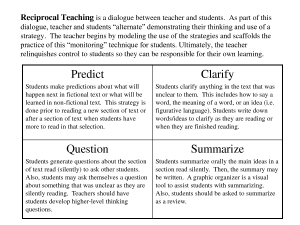Why Singapore’s English Teachers Should Embrace Singlish, Not Fight It
Is it time for Singaporean educators to embrace Singlish as a legitimate learning tool? What the Research […]
Read More
Autonomy-supportive teaching refers to a set of teacher behaviours that can facilitate independent learning by identifying and developing students’ interests and inner motivations (Reeve, 2016). It is based on an interpersonal relationship between teachers and students that can support the latter’s need for autonomy. In his presentation at the Redesigning Pedagogy International Conference 2022, Dr Ravinder Mohan Sharma from Edgefield Secondary School discusses the six autonomy-supportive instructional behaviours as well as his research study on reciprocal teaching.

Reciprocal teaching is a scaffolded instructional technique that is used to improve students’ ability in reading and learning (Palincsar & Brown, 1984). It uses four main strategies (see Figure 1) in which the teacher guides the students to predict, clarify, question and summarize when working on a comprehension text.
“Reciprocal teaching is actually a dialogue between teacher and students. The teacher begins by modeling the use of the strategies and scaffolds the practice of this technique for students. The ultimate goal is for the teacher to relinquish control to students so that they can be responsible for their own learning,” Dr Ravinder Mohan Sharma, Lead Teacher (Learning Needs), from Edgefield Secondary School, explains.
In his five-week observation of reciprocal teaching that was adopted in two upper secondary English language classes, he notes that the approach has received a positive response from students.
“Students gave feedback that using the four main strategies has helped them to be better self-directed learners and understand comprehension texts better,” he shares. “Through repeated practice of the four strategies, we hope that they can have a deepened sense of how to apply them in the long run.”
In his virtual presentation at the education conference, he discusses how teachers can leverage on reciprocal teaching to enhance autonomy-supportive behaviours.

Figure 1. The four strategies of reciprocal teaching.
Ravinder shares that there are six autonomy-supportive instructional behaviours that teachers can adopt in the classroom to nurture independent learning.
The first is being mindful of the students’ perspectives. “When teachers adopt the students’ frame of reference, they become more empathetic and empowered to create classroom conditions to support students’ autonomy,” he says.
For example, teachers using reciprocal teaching as an approach are advised to first understand the students’ level of readiness to work on a particular comprehension text. “The choice of comprehension texts used in the classroom determines whether the application of the four roles for reciprocal teaching can happen. Thus, when choosing a text, teachers need to match the difficulty level of the text with the students’ readiness,” he explains.
Second, it is crucial for teachers to consider how they can nurture and develop student curiosity and intrinsic goals. This will in turn build up their confidence in the subject.
“In reciprocal teaching, the teacher will provide opportunities for students to rotate within the four roles – predict, clarify, question and summarize – when working in groups on the comprehension text,” he shares. “Curiosity and interest value are likely to increase when, for example, those in the ‘predict’ role are instructed to anticipate what might happen in the text.”
The third behaviour is providing an explanatory rationale. This may include telling students the benefits of doing a particular lesson activity so that they will feel more motivated and engaged to learn.
“In teaching comprehension, teachers can explain why text analysis is important and how these strategies can help them later in independent work and assessments,” he advises.
The language used when communicating with students matters too. He explains that teachers need to use non-pressurizing informational language.
“Non-pressurizing refers to the absence of words such as ‘should’, ‘have to’, and ‘must’ while informational language conveys choice and flexibility that encourages students to solve problems on their own,” he notes.
In reciprocal teaching, teachers are encouraged to allow their students to provide a range of questions and possible answers. Adopting an encouraging tone, teachers also reassure their students that there are no incorrect answers during the discussion stage.
However, he notes that teachers should be prepared that some students may, for example, request not to participate or express doubt in their ability to engage with the lesson activity. Instead of dismissing their concerns, teachers need to acknowledge the students’ expression of negative effect. In these situations, teachers may consider asking for suggestions on how to go about the lesson better.
The sixth and last behaviour is having the patience to withhold the answers to the questions and postponing help until a suitable time in the particular lesson. “Teachers should be responsive only when there is a serious need to. Students should be given the opportunity to work at their own pace,” he explains.
He emphasizes that the six autonomy-supportive behaviours must be enacted synergistically over lessons. When practiced in tandem over time, the six behaviours can help students become more in sync with the learning activity or subject matter.
“Student satisfaction, curiosity, interest and goal progress can become high probability occurrences when teachers show new ways of interacting with the learning activity,” he adds.
“To encourage students to be independent learners, teachers have to be mindful that they have to withhold answers until a suitable time. The culture of deference needs to give way to more self-directed independence practices in order to raise student efficacy in their own learning.”
– Ravinder, on what teachers can do to nurture independent learners
Ravinder admits that there are some limitations to reciprocal teaching. His research study has shown that more time and commitment are needed in order to build up student confidence in using the four roles.
“A teacher gave feedback that some students had requested for more explanations from him to ensure that they were on the right track. The need for more time remains a concern,” he says.
He also highlights that there is a culture of deference to teachers that needs to be gradually reduced. In one of his observations, he notes that some students still preferred teachers to provide the explanations and answers.
“To encourage students to be independent learners, teachers have to be mindful that they have to withhold answers until a suitable time. The culture of deference needs to give way to more self-directed independence practices in order to raise student efficacy in their own learning,” he affirms.
The research study has inspired Ravinder to look into how there could be a re-thinking of new and old strategies to improve students’ independent learning in other English assessments such as oral communication and writing.
He also hopes that reciprocal teaching and autonomy-supportive instructional behaviours can be extended beyond learning and reading comprehension. “Future studies can explore how the six autonomy-supportive instructional behaviours can be enhanced beyond the English classroom. We can look at how, for example, other forms of adapted reciprocal teaching can be used to teach the water cycle during Science lessons,” he shares.
References
Palincsar, A. S., & Brown, A. L. (1984). Reciprocal teaching of comprehension-fostering and comprehension-monitoring activities. Cognition and Instruction, 1(2), 117–175.
Reeve, J. (2016). Autonomy-Supportive Teaching: What it is, How to do it. In W.C. Liu, K.W.J. Chee, & Ryan, R.M. (Eds.), Building Autonomous Learners. Springer